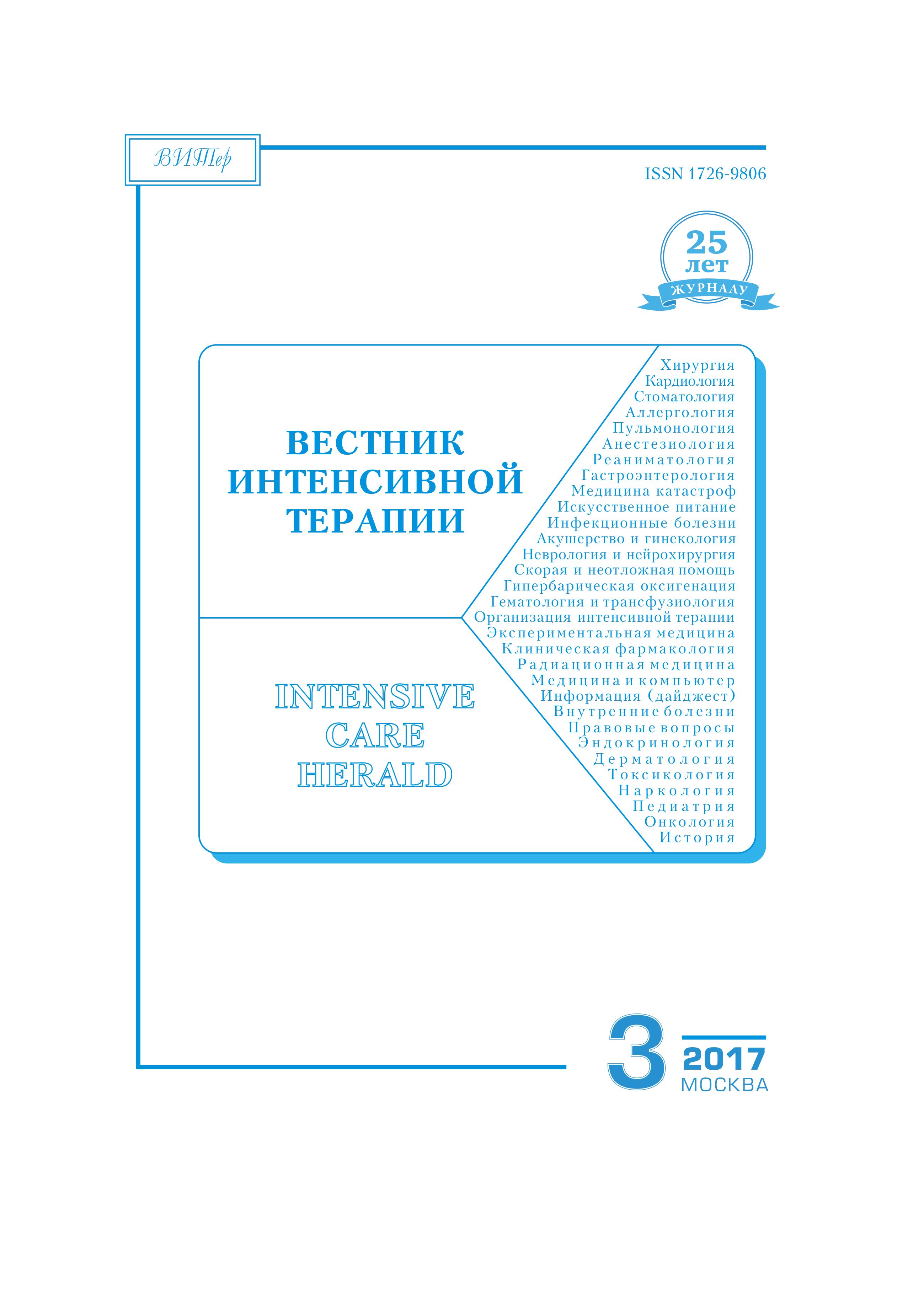Аннотация
Цель исследования. Обобщение и анализ имеющихся данных о влиянии полиморфизма μ-опиоидного рецептора OPRM1 A118G на потребность в наркотических анальгетиках в ранний послеоперационный период. Материал и методы. В исследование взята информация, полученная из SCOPUS, MedLine, EMBASE. Было проанализировано 34 работы. Критерии включения в метаанализ: оригинальные исследования, посвященные данному вопросу. Критерии исключения: обзорные статьи, статьи, посвященные влиянию изучаемого полиморфизма на боль, не связанную с оперативным лечением (роды, онкологическая боль, хроническая боль), а также работы, в которых авторы изучали влияние полиморфизма μ-опиоидного рецептора OPRM1 A118G на потребность в наркотических анальгетиках при эпидуральном или интратекальном способах введения. После проведенного отбора в метаанализ были включены данные 6 работ (1691 пациент). Анализировалась разница в потребности наркотических анальгетиков в первые 24 ч в зависимости от генотипа OPRM1. Результаты. При проведении исследования установлено, что гомозиготные носители А-аллеля μ-опиоидного рецептора OPRM1 нуждались в меньших дозах наркотических анальгетиков в сравнении с гетеро- (модель фиксированных эффектов; Z = −10,172; p = 0,0001; I2 = 54,1 %) и гомозиготными (модель фиксированных эффектов; Z = −6,543; p = 0,0001; I2 = 81,7 %) носителями G-аллеля. Вывод. Полиморфизм μ-опиоидного рецептора OPRM1 A118G влияет на индивидуальную потребность в наркотических анальгетиках в ранний послеоперационный период.
Библиографические ссылки
- Овечкин А.М., Шадрин Р.В., Шифман Е.М., Заболотских И.Б. Возможности и перспективы внедрения рекомендаций Американского общества боли по лечению послеоперационной боли (2016) в российскую клиническую практику, с учетом законодательных норм РФ, финансовой политики в области здравоохранения и традиционных подходов к лечению боли. Регионарная анестезия и лечение острой боли. 2017; прил. 1: S4–S42. doi: 10.18821/1993-6508-2017-11-Supplement01-S4-S42. [Ovechkin A.M., Shadrin R.V., Shifman E.M., Zabolotskikh I.B. Scopes and perspectives for introduction of American Pain Society clinical practical guideline on the management of postoperative pain (2016) to russian clinical practice, with considering the russian federation legislative norms, financial healthcare policy and traditional approaches for pain treatment. Regionarnaya anesteziya i lechenie ostroy boli. 2017; prilozhenie 1: S4–S42. (In Russ)]
- Осипова Н.А. Послеоперационное обезболивание в России: клинические и организационные аспекты. Общая реаниматология. 2013; 9(4): 5–10. [Osipova N.A. Posleoperatsionnoe obezbolivanie v Rossii: klinicheskie i organizatsionnye Obshchaya reanimatologiya. 2013; 9(4): 5–10. (In Russ)]
- Дугиева М.З., Свиридов С.В., Слепцова Н.И., Морозова К.В. Факторы риска развития длительного болевого синдрома после гинекологических операций. Общая реаниматология. 2012; 8(5): 56–60. [Dugieva M.Z., Sviridov V., Sleptsova N.I., Morozova K.V. Faktory riska razvitiya dlitel’nogo bolevogo sindroma posle ginekologicheskikh operatsiy. Obshchaya reanimatologiya. 2012; 8(5): 56–60. (In Russ)]
- Huang P., Chen C., Mague S.D. et al. A common single nucleotide polymorphism A118G of the μ-opioid receptor alters its N-glycosylation and protein stability. Biochem. J. 2012; 441(1): 379–386. doi: 1042/BJ20111050.
- Bond C., LaForge K.S., Tian M. et al. Single-nucleotide polymorphism in the human mu opioid receptor gene alters beta-endorphin binding and activity: possible implications for opiate addiction. Natl. Acad. Sci. USA. 1998; 95(16): 9608–9613.
- Chou W.Y., Wang C.H., Liu H. et al. Human opioid receptor A118G polymorphism affects intravenous patient-controlled analgesia morphine consumption after total abdominal hysterectomy. Anesthesiology 2006; 105: 334–337.
- Zhang W., Yuan J., Kan Q.C. Association of human micro-opioid receptor gene polymorphism A118G with fentanyl analgesia consumption in Chinese gynaecological patients. Anaesthesia. 2010; 65(2): 130–135.
- Chou W.Y., Yang C., Lu H.F. et al.. Association of mu-opioid receptor gene polymorphism (A118G) with variations in morphine consumption for analgesia after total knee arthroplasty. Acta Anaesthesiol. Scand. 2006; 50: 787–792.
- Zhang W., Yuan J.J., Kan Q.C. et al. Study of the OPRM1 A118G genetic polymorphism associated with postoperative nausea and vomiting induced by fentanyl intravenous Minerva Anestesiol. 2011; 77: 33–39.
- Boswell M.V., Stauble M.E., Loyd G.E. et al. The role of hydromorphone and OPRM1 in postoperative pain relief with Pain Physician. 2013; 16: E227–E235.
- Tan C., Lim E.C., Teo Y.Y. et al. Ethnicity and OPRM variant independently predict pain perception and patient-controlled analgesia usage for post-operative pain. Mol. Pain. 2009; 5: 32.
- Дембицкий C.С. Метаанализ: ключевые понятия и основы вычислений (на примере данных кросс-национальных исследований). Социология: теория, методы, маркетинг. 2012; 3: 160–174. [Dembitskiy S.S. Metaanaliz: klyuchevye ponyatiya i osnovy vychisleniy (na primere dannykh kross-natsional’nykh issledovaniy). Sotsiologiya: teoriya, metody, marketing. 2012; 3: 160–174. (In Russ)]
- Ren Y., Xu X.Q., Bao Y.P. et al. The impact of genetic variation on sensitivity to opioid analgesics in patients with postoperative pain: a systematic review and meta-analysis. Pain Physician. 2015; 18(2): 131–152.
- Bond C., LaForge K.S., Tian M. et al. Single-nucleotide polymorphism in the human mu opioid receptor gene alters beta-endorphin binding and activity: possible implications for opiate addiction. Natl. Acad. Sci. USA. 1998; 95(16): 9608–9613.
- Oertel B.G., Kettner M., Scholich K. et al. A common human micro-opioid receptor genetic variant diminishes the receptor signaling efficacy in brain regions processing the sensory information of J. Biol. Chem. 2009; 284(10): 6530–6535.
- Crist R.C., Berrettini W.H. Pharmacogenetics of OPRM1. Biochem. Behav. 2014; 123: 25–33.
- Nestler E.J. Common molecular and cellular substrates of addiction and memory. Neurobiol. Learn. Mem. 2002; 78(3): 637–647.

Это произведение доступно по лицензии Creative Commons «Attribution-NonCommercial-ShareAlike» («Атрибуция — Некоммерческое использование — На тех же условиях») 4.0 Всемирная.
Copyright (c) 2017 ВЕСТНИК ИНТЕНСИВНОЙ ТЕРАПИИ имени А.И. САЛТАНОВА

